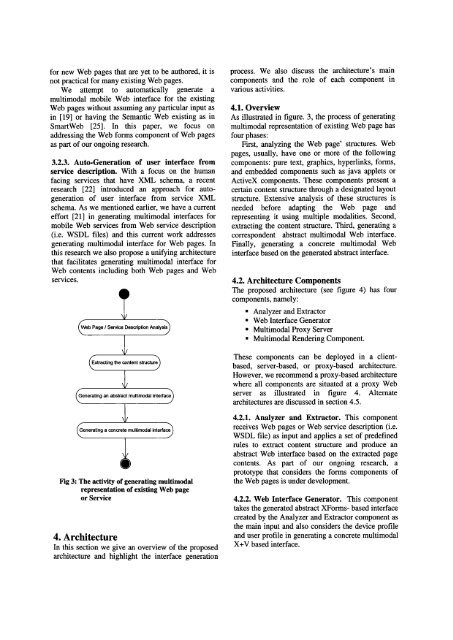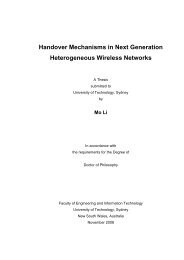WSEAS TRANSACTIONS on COMPUTERS Issue 12, Volume 4 ...
WSEAS TRANSACTIONS on COMPUTERS Issue 12, Volume 4 ...
WSEAS TRANSACTIONS on COMPUTERS Issue 12, Volume 4 ...
You also want an ePaper? Increase the reach of your titles
YUMPU automatically turns print PDFs into web optimized ePapers that Google loves.
for new Web pages that are yet to be authored, it is<br />
not practical for many existing Web pages.<br />
We attempt to automatically generate a<br />
multimodal mobile Web interface for the existing<br />
Web pages without assuming any particular input as<br />
in [19] or having the Semantic Web existing as in<br />
SmartWeb [25]. In this paper, we focus <strong>on</strong><br />
addressing the Web forms comp<strong>on</strong>ent of Web pages<br />
as part of our <strong>on</strong>going research.<br />
3.2.3. Auto-Generati<strong>on</strong> of user interface from<br />
service descripti<strong>on</strong>. With a focus <strong>on</strong> the human<br />
facing services that have XML schema, a recent<br />
research [22] introduced an approach for autogenerati<strong>on</strong><br />
of user interface from service XML<br />
schema. As we menti<strong>on</strong>ed earlier, we have a current<br />
effort [21] in generating multimodal interfaces for<br />
mobile Web services from Web service descripti<strong>on</strong><br />
(i.e. WSDL files) and this current work addresses<br />
generating multimodal interface for Web pages. In<br />
this research we also propose a unifying architecture<br />
that facilitates generating multimodal interface for<br />
Web c<strong>on</strong>tents including both Web pages and Web<br />
services.<br />
Web Page I Service Descripti<strong>on</strong> Analysis<br />
Extracting the c<strong>on</strong>tent structure<br />
Generating an abstract multimodal interface<br />
Generating a c<strong>on</strong>crete multimodal interface<br />
Fig 3: The activity of generating multimodal<br />
representati<strong>on</strong> of existing Web page<br />
or Service<br />
4. Architecture<br />
In this secti<strong>on</strong> we give an overview of the proposed<br />
architecture and highlight the interface generati<strong>on</strong><br />
process. We also discuss the architecture's main<br />
comp<strong>on</strong>ents and the role of each comp<strong>on</strong>ent in<br />
various activities.<br />
4.1. Overview<br />
As illustrated in figure. 3, the process of generating<br />
multimodal representati<strong>on</strong> of existing Web page has<br />
four phases:<br />
First, analyzing the Web page' structures. Web<br />
pages, usually, have <strong>on</strong>e or more of the following<br />
comp<strong>on</strong>ents: pure text, graphics, hyperlinks, forms,<br />
and embedded comp<strong>on</strong>ents such as java applets or<br />
ActiveX comp<strong>on</strong>ents. These comp<strong>on</strong>ents present a<br />
certain c<strong>on</strong>tent structure through a designated layout<br />
structure. Extensive analysis of these structures is<br />
needed before adapting the Web page and<br />
representing it using multiple modalities. Sec<strong>on</strong>d,<br />
extracting the c<strong>on</strong>tent structure. Third, generating a<br />
corresp<strong>on</strong>dent abstract multimodal Web interface.<br />
Finally, generating a c<strong>on</strong>crete multimodal Web<br />
interface based <strong>on</strong> the generated abstract interface.<br />
4.2. Architecture Comp<strong>on</strong>ents<br />
The proposed architecture (see figure 4) has four<br />
comp<strong>on</strong>ents, namely:<br />
• Analyzer and Extractor<br />
• Web Interface Generator<br />
• Multimodal Proxy Server<br />
• Multimodal Rendering Comp<strong>on</strong>ent.<br />
These comp<strong>on</strong>ents can be deployed in a clientbased,<br />
server-based, or proxy-based architecture.<br />
However, we recommend a proxy-based architecture<br />
where all comp<strong>on</strong>ents are situated at a proxy Web<br />
server as illustrated in figure 4. Alternate<br />
architectures are discussed in secti<strong>on</strong> 4.5.<br />
4.2.1. Analyzer and Extractor. This comp<strong>on</strong>ent<br />
receives Web pages or Web service descripti<strong>on</strong> (i.e.<br />
WSDL file) as input and applies a set of predefined<br />
rules to extract c<strong>on</strong>tent structure and produce an<br />
abstract Web interface based <strong>on</strong> the extracted page<br />
c<strong>on</strong>tents. As part of our <strong>on</strong>going research, a<br />
prototype that c<strong>on</strong>siders the forms comp<strong>on</strong>ents of<br />
the Web pages is under development.<br />
4.2.2. Web Interface Generator. This comp<strong>on</strong>ent<br />
takes the generated abstract XForms- based interface<br />
created by the Analyzer and Extractor comp<strong>on</strong>ent as<br />
the main input and also c<strong>on</strong>siders the device profile<br />
and user profile in generating a c<strong>on</strong>crete multimodal<br />
X+V based interface.












